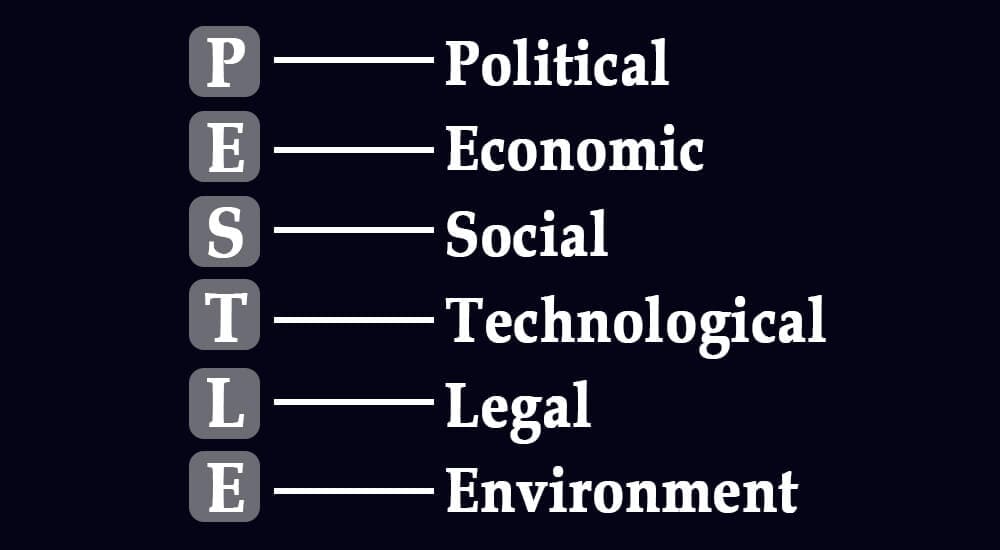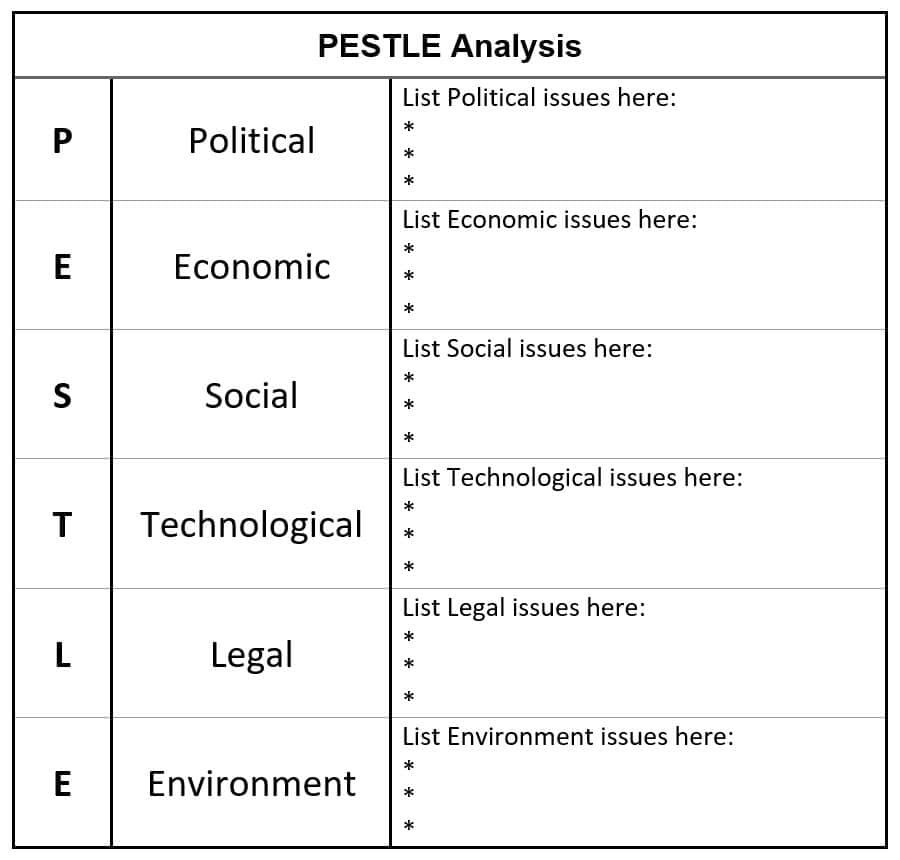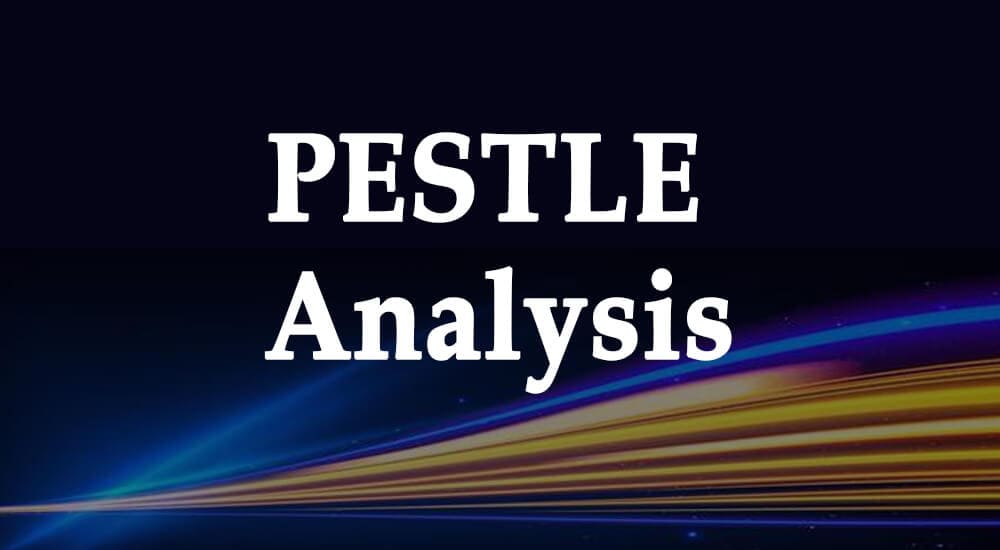A PESTLE analysis studies vital external factors (political, economic, sociological, technological, legal, and environmental) that influence an organization and help guide management to make strategic decisions.
Businesses use this technique to scan their current or prospective environments, especially when planning to launch a new project, product, or service.
Every organization focuses on growth. However, competition is so fierce that any wrong move can be disastrous. Therefore, it is critical for businesses to keep a close eye on every decision and perform a proper analysis.
Organizations can manage internal factors, but driving external factors is beyond their control.
Political situations, governmental regulations, technological improvements, environmental concerns, legitimacy of activities, commerce, and sociological factors all play a role.
PESTEL analysis helps businesses review these factors.

Earlier it was known as PEST analysis. Later, legal and environmental factors were added, and now experts debate adding ethics into the framework.
Why is PESTLE Analysis Used?
PESTLE analysis studies how various factors can affect a startup or a new business.
It examines the impact of politics, economics, society, technology, law, and environments on new businesses. This analysis helps organizations understand how smoothly they can operate with the factors.
PESTLE analysis is essential in business planning as it helps organizations understand the risks factors associated with a business.
This analysis also provides insight on policies, for example, decisions and policies regarding suitable business location, product development, marketing planning, staff and workforce recruitment, planning, and other organizational changes.
Small and large businesses use PESTLE analysis used to determine trends. It helps assess scalability options, possibilities, and whether the value or service will remain relevant in the long term.
The Six PESTLE Factors
#1. Political
Political factors include taxation, ecological regulations, trade constraints and deregulation, taxes, and social stability. This factor focuses on how political conditions in a country can affect the business, like tax restrictions, custom rules, and non-tariff hurdles (like minimum import prices and export bans).
It also includes penalties for tax-related offenses such as tax fraud.
Industry regulations that refer to laws regarding the operation of specific types of businesses can be political factors.
Agreements and restrictions concerning global and international trade guidelines or foreign policy.
#2. Economic
Economic issues play a significant role in business decisions. Growth, cost of living, top-quality trade, hyperinflation, access to credit, wage levels, unemployment (local and national), minimum wage, and working hours are a few examples of economic factors.
Inflationary pressures in any industry can influence the product pricing structure. It affects consumers’ bargaining capacity and causes a shift in the country’s economic demand/supply patterns.
#3. Social
Social norms and preconceptions, health consciousness, demographic growth rates, age distribution, vocational choices, well-being, and safety are critical factors for businesses to evaluate. These elements are crucial for advertisers to understand if they wish to attract a specific audience.
Social factors help businesses make plans that distinguish them from competitors.
Analyzing social factors helps organizations understand individual lifestyle choices, population demographics such as age, gender, cultural principles, consumer tastes, and buying habits.
#4. Technological
This factor examines how a business responds to technological advancements and how this is reflected in its products and services. It considers how innovations will affect security and data storage.
Technical aspects are advances and discoveries; these factors greatly affect the business operations. Artificial intelligence, the Internet of Things, computer vision, and pattern recognition ensure that the corporation maintains its market advantage.
Disruptive technologies are also analyzed. This includes smartphones, robotics, and automation. The increasing shift towards artificial intelligence is also studied in this category.
#5. Legal
This factor considers labor laws and employment regulations that affect working practices. It focuses on legislation and regulations regarding health and safety environments. Progress in the legal landscape is also monitored.
In addition to these rules and norms, organizations establish choices and regulations that their delegates must follow.
#6. Environmental
These criteria assess the impact of the ecological and environmental factors, such as laws on energy use, environmental preservation, and refuse management.
Environmental degradation and transitions to renewable energy compel every company to address ecological factors. Because of this, firms must now engage in Corporate Social Responsibility (CSR). This PESTLE component is critical for specialist industries such as ecotourism, agriculture, and agribusiness.
Environmental factors examine a business whether it directly impacts the environment.
PESTLE Analysis Process
#1. Determine the Research’s Scope
This is the first step. The scope analysis should examine the possible business scenarios, both present, and future. It should be feasible and applicable to the business’ industry and locations.
#2. Data Collection
Identify multiple people to collect data to bring in a variety of evidence and viewpoints and determine how it will be gathered. Analysts seek the best sources when scouting for information.
#3. Data Analysis
The following steps ensure correct data analysis:
- Assign a value to each item based on its potential risk to the organization.
- Determine alternatives for handling business problems.
- Document all findings for further discussion.
- Inform decision-makers and stakeholders of findings.
- Find the necessary activities and identify trends that must be tracked.
PESTLE analysis can aid in the early detection of trends and create a competitive advantage. A couple of PESTLE analysis templates are available online and can be utilized to record information.
PESTLE Analysis Template

Advantages and Disadvantages of PESTLE Analysis
Advantages
- PESTLE analysis is a straightforward structure that is easy to understand and implement.
- It clarifies the corporate environment and its structure.
- PESTLE analysis encourages strategic thinking while planning a business.
- It helps a business predict future threats.
- PESTLE analysis helps a company identify and utilize business advantages and opportunities.
Disadvantages
- Decisions based on PESTLE analysis may only consider incomplete or insufficient information.
- The danger of too much data—relevant and irrelevant—can cause “analysis paralysis.”
- Take note of assumptions; they can be wrong.
- Parameters can change quickly, so it may be challenging to foresee detrimental future changes.
- PESTLE analysis must be repeated regularly to be effective.
Conclusion
PESTLE analysis is a valuable tool for organizations to prepare them for difficulties. Whether growing a line of products or creating a new organization in a new region, PESTLE analysis is critical in formulating plans and strategies.
PESTLE analysis offers a holistic overview of a business’s surroundings to all key aspects which may affect the work. It is the foundation of an organization, defining the factors that affect its goals. It’s deeper than just knowing how to read a market. Research has shown that companies who are swift to detect and adapt set themselves apart from their competition.
